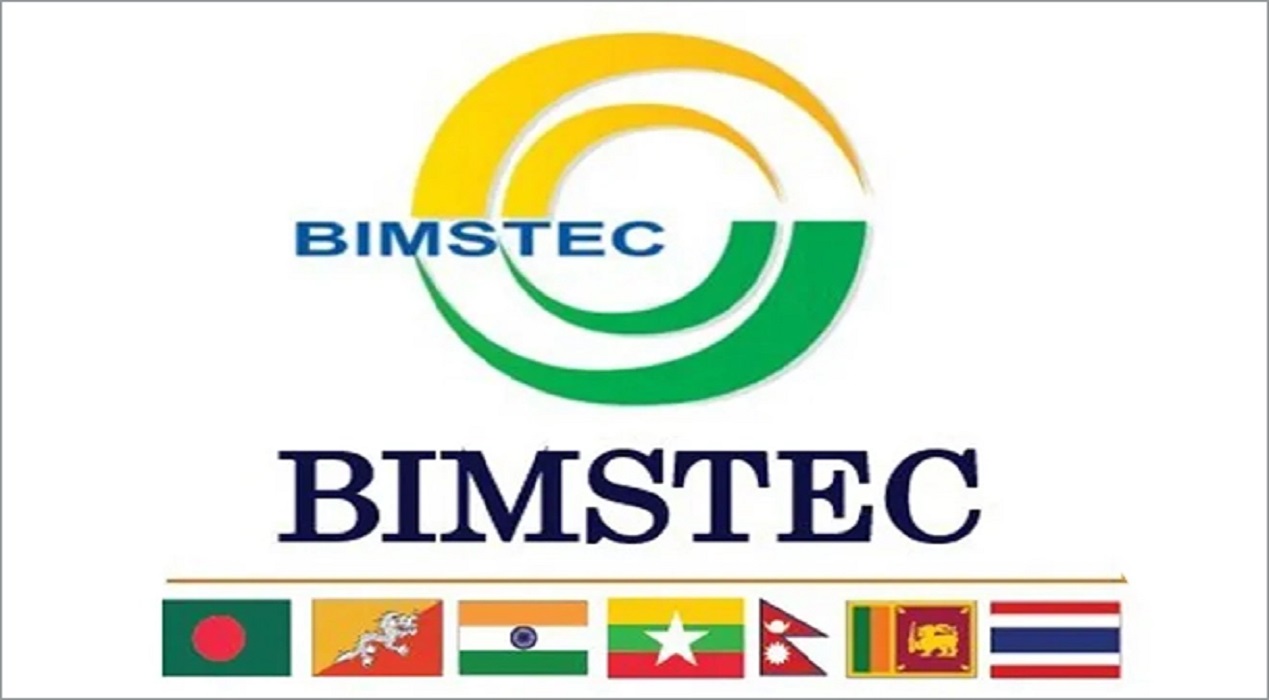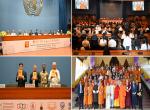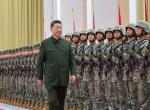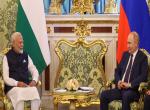Sri Lankan President Gotabaya Rajapaksa hosted the 5th BIMSTEC (Bay of Bengal Initiative for Multi-Sectoral Technical and Economic Cooperation) Summit in a “hybrid mode” from 28 to 30 March 2022, marking the grouping’s 25 years of existence. As was expected, member states focussed on new kind of challenges that the region has been facing post-Covid-19 pandemic. As the host, Sri Lanka has been facing acute foreign exchange crisis, severely impacting on the import of oil and other critical resources. As a result, the island nation resorted to power cuts to the extent of 13 hours daily, disrupting normal lives of people. The political situation has turned very volatile. A regime change could be a possibility. It was therefore a good opportunity for Sri Lanka as the host to enlighten other member states and seek a common response to issues such as institutional infrastructure building and rationalising other critical areas necessary for regional economic growth. As an immediate measure, India has responded by sending humanitarian assistance in the form of rice, wheat, fuel and other items in emergency basis.
Besides the debt trap looming large, Sri Lanka is facing daunting problems and worst economic crisis in recent memory with shortages of medicine, fuel, fertilizers and milk powder. The debt crisis partly stems from infrastructure projects that were financed with Chinese loans but proved to be economically unviable. As a result, Sri Lanka’s foreign exchange reserves dwindled and its repayment commitment ballooned to $7 billion in 2022 alone.
As a responsible neighbour and a BIMSTEC partner committed to maintain stability and economic development in the region, India immediately agreed to provide a $1 billion credit line to Sri Lanka to buy essentials and $500 million to help ease crippling shortages of essential items, including fuel, food and medicine. Though Sri Lanka has also requested China for an economic assistance of $2.5 billion, China has remained non-committal about restructuring billions in debt. This demonstrates China’s real intentions that its own interests always prevails over another nation with which it does business. This is China’s predatory tactics which many countries across the world that have joined China’s BRI projects fail to notice. Sri Lanka’s example is a clear example of China’s dirty business strategy.
With SAARC being in existence for decades despite India’s pro-activism, SAARC has not proved to be a viable and effective organisation to foster regional unity solely because Pakistan’s agenda has remained always at variance with what India has defined in its foreign policy priorities. Thus, with SAARC in coma, India preferred to invest its hopes for regional cooperation in BIMSTEC, which does not have Pakistan as a member.
What is BIMSTEC?
It is a regional organisation comprising seven member states lying in the littoral and adjacent areas of the Bay of Bengal constituting a contiguous regional unity. The organisation came into being on 6 June 1997 through the Bangkok Declaration. Of the seven members, five are from South Asia (Bangladesh, Bhutan, India, Nepal, and Sri Lanka) and two from Southeast Asia (Myanmar and Thailand). In February 2004, the acronym BIMSTEC gained currency.
The regional grouping was conceived to be a bridge between South and South East Asia, thereby representing a reinforcement of relations among these countries. The BIMSTEC region being home to around 1.5 billion people constituting around 22 per cent of the global population with a combined gross domestic product of 2.7 trillion economy, it is a platform for intra-regional cooperation between SAARC and ASEAN members.
The Rationale
The rationale behind this alliance was to harness shared and accelerated growth through mutual cooperation in different areas of common interests by mitigating the onslaught of globalisation and by utilizing regional resources and geographical advantages. BIMSTEC is a sector-driven cooperative organisation. Initially six sectors were identified for priority areas for cooperation – trade, technology, energy, transport, tourism and fisheries. Subsequently, nine more areas were added. These are agriculture, public health, poverty alleviation, counter-terrorism, environment, culture, people-to-people contact and climate change.
India’s Position
While addressing the summit through a video conference, Prime Minister Narendra Modi stressed on the importance of connectivity as movement of goods and people smoothly shall facilitate economic development and therefore stability in the region. A Charter was adopted along with a master plan for transport connectivity, with a complete revamp of the group’s functioning into seven pillars. India heads the important security pillar to combat, of which terrorism and other crimes are important components. PM Modi underlined the importance of regional security in the wake of developments in Europe having raised questions about the stability of the global order and therefore called upon the BIMSTEC member states to be more active on the regional security matters. The Charter formalised BIMSTEC member states “littoral to, and dependent upon, the Bay of Bengal”. Modi too pushed for early progress on the proposal of BIMSTEC free trade agreement (FTA) to enhance mutual trade among member states.
India announced that it would provide $1 million in financial aid to augment the operational budget of the BIMSTEC secretariat. Stressing to enhance exchanges between the entrepreneurs and start-ups, Modi emphasised on the need to adopt international norms in the field of trade facilitation, intra-BIMSTEC trade and economic integration. Indeed, the region continues to suffer the effects of the Covid-19 pandemic and a collective response by member states shall alleviate the pains felt by over a billion people in the region.
Among other highlights are agreements to boost ongoing cooperation activities, including BIMSTEC Convention on Mutual Legal Assistance in Criminal Matters, MoU on Mutual Cooperation in the field of Diplomatic Training and Memorandum of Association on Establishment of BIMSTEC Technology Transfer Facility. The 10-year Master Plan for Transport Connectivity was also adopted to govern connectivity-related activities in the region. Prime Minister Modi emphasised the importance of the institutional architecture to manage and give direction to the programmes outlined in the roadmap. Modi called for making BIMSTEC “a Bridge of Connectivity, Bridge of Prosperity, Bridge of Security”.
Speaking at the 18th BIMSTEC ministerial meeting, External Affairs Minister S. Jaishankar exhorted the member states to fight together the security challenges arising from the conflict in Ukraine. He suggested therefore the creation of a legal architecture to counter challenges such as terrorism, trans-national crime and cyber attacks that can affect economic development. While speaking with his Sri Lankan counterpart, he offered to share India’s expertise in creating a national database in the form of Aadhaar card for a similar programme in Sri Lanka. He also offered India’s help in setting up hybrid power projects in three islands off Jaffna, effectively replacing energy projects by a Chinese firm. It may be recalled that when Sri Lanka awarded the power projects in Neduntheevu, Nainativu and Analaitivu to a Chinese firm in January 2021, India had objected as the projects were to be built in an area 50 km away from the Tamil Nadu coastline.
Countering China
The above deal could be as a step towards keeping China’s growing influence in the Indian Ocean in check. When in December 2021 China suspended its plan to build power plants on three Sri Lankan islands due to security concerns, India stepped in. The BIMSTEC summit came at an opportune time for India to play this critical role in Sri Lanka. For India, Sri Lanka just across the narrow Palk Strait off its south-eastern coast remains under its sphere of interest. The geographical location of the island nation in the middle of a key sea route connecting East and West and therefore China finds it suitable to its interest to further its ambitious ‘One Belt One Road’ initiative. Such a strategy goes counter to India’s own interests. China lured the island nation with attractive terms of business protecting its own interests and exposing Sri Lanka’s vulnerability resulting in debt trap.
Myanmar Issue
The Myanmar issue emerged as a delicate one at the BIMSTEC summit. Like on other global issues, India’s stance on Myanmar following the military takeover of the civilian government has remained nuanced, consistent and principled. India’s own strategic interests define its Myanmar policy. Despite that and like in Ukraine, the Western world has imposed crippling sanctions on Myanmar; India has resisted the pressure to join the sanctions bandwagon, preferring dialogue and discussion as the preferred routes to resolve the crisis.
As was expected, the US that has tried to isolate Myanmar internationally issued a demarche to BIMSTEC Chair Sri Lanka for having invited Myanmar’s Foreign Minister U. Wunna Maung Lwin to represent his country at the virtual summit.
The US had similar reservations about India’s stance on Myanmar. It is known that India has not joined efforts by the West, as with Russia over Ukraine too, to isolate Myanmar. India maintains that its Myanmar policy is based on its security interests. China’s expanding influence in Myanmar is also a concern for India. It was but appropriate that India stuck to its position that the signing of the Charter formalises the group as an organisation of member states that are littoral to, and dependent upon, the Bay of Bengal.
Conclusion
In conclusion it can be said that though SAARC has been in existence for decades yet it has become virtually defunct, defanged and not delivering the intended objectives. India reasonably, and correctly, therefore finds merit in making efforts to see BIMSTEC as a vibrant alternative regional forum to address security and counter terrorism issues, foster economic growth and others, to be addressed collectively.
(The paper is the author’s individual scholastic articulation. The author certifies that the article/paper is original in content, unpublished and it has not been submitted for publication/web upload elsewhere, and that the facts and figures quoted are duly referenced, as needed, and are believed to be correct). (The paper does not necessarily represent the organisational stance... More >>
Image Source: https://www.orfonline.org/wp-content/uploads/2022/03/Bimstec-2022.jpg











Post new comment